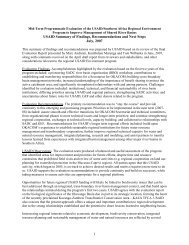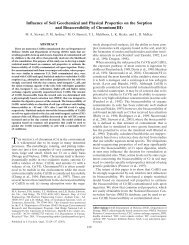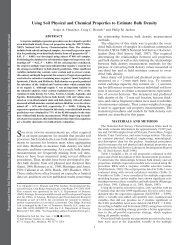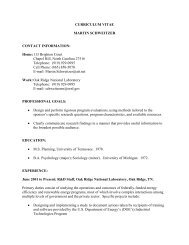Reptile and Amphibian Abundance and Distribution Survey - Oak ...
Reptile and Amphibian Abundance and Distribution Survey - Oak ...
Reptile and Amphibian Abundance and Distribution Survey - Oak ...
- No tags were found...
You also want an ePaper? Increase the reach of your titles
YUMPU automatically turns print PDFs into web optimized ePapers that Google loves.
Northern Red Salam<strong>and</strong>er—Pseudotriton ruber ruberNorthern red salam<strong>and</strong>ers range throughout the southeasternUnited States <strong>and</strong> up the eastern seaboard to New York. They aremost commonly found in slow-moving permanent streams, nearsprings, <strong>and</strong> in some bogs. They rely on heavy leaf litter, logs, <strong>and</strong>burrows as habitats <strong>and</strong> can sometimes live in streams that come outof caves.Northern red salam<strong>and</strong>ers are most active at night <strong>and</strong> feed onsmall insects. During rainy nights they will stray far from water.They are known to give off toxic skin secretions when attacked.Northern red salam<strong>and</strong>ers mate during fall <strong>and</strong> summer, <strong>and</strong>Photo by Scott Reasoreggs are laid in early fall. Females will often bunch nests togetherfor safety. Once hatched, the larvae take 2 years to metamorphose. Sexual maturity is reached after 4 to 6years. The northern red salam<strong>and</strong>er’s population is stable throughout its range.Red Spotted Newt—Notophthalmus viridescens viridescensRed spotted newts, also known as eastern newts, occurthroughout the eastern United States from central Texas to theAtlantic coast. The red spotted newt thrives in a variety ofst<strong>and</strong>ing freshwater habitats, such as shallow wetl<strong>and</strong>s, beaverponds, marshes, bays, <strong>and</strong> artificial ponds.Red spotted newts have distinct life stages. After hatching,the larvae stay in water for approximately 2 /5 months. Then,the newts transform into their eft stage as juveniles <strong>and</strong> becometerrestrial creatures. After up to 7 years, the efts return to thewater as adults. Red spotted newts feed primarily on insects,worms, leeches, larvae, <strong>and</strong> eggs of amphibians.Study PhotoBreeding takes place from fall to early summer. Females areattracted to males with their spots <strong>and</strong> with the chemicals they give off. Amplexus in newts can lastseveral hours, ending when the males release spermatophores on the bottom of the pond. Thespermatophores are then picked up by the females. Red spotted newts can live up to 15 years in captivity,but few make it past the larval stage in the wild. Their habitats are plentiful, <strong>and</strong> they are stablethroughout their range.A-12
















